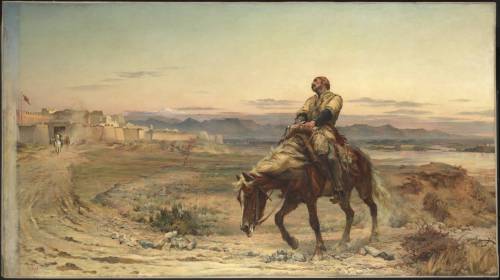The First Anglo Afghan War Part III — The Bloody Retreat from Kabul.In case you missed Part I,
The First Anglo Afghan War Part III — The Bloody Retreat from Kabul.In case you missed Part I, Part IIBy the end of 1841, it was quite clear to the British that they could not maintain an orderly hold over Afghanistan. All over the country Afghan tribes and warlords were rising up in rebellion against the British. The British had even lost control of the capital, Kabul, and were forced to man a poorly defensible position outside the city. Supply lines had been cut off, and a large army under the command of Akbar Khan was on its way to destroy the British. Without supplies and reinforcements, for British commander Major General Sir William Elphinstone, it was quite clear that his army had only one option, to retreat or face total destruction.On January 6th, 1842 Elphinstone’s Army set out out the safety of the British garrison at Jalalabad over 90 miles away. The army consisted of 4,500 Indian and British soldiers, as well a 12,000 civilian camp followers. The trek was especially hazardous because of the lack of supplies, the harsh Afghan winter, the exceedingly rough terrain of the Hindu Kush Mountains, and worst of all, the ambushes conducted by Ghilji tribesmen who inhabited the mountains. Under negotiations, Akbar Khan had agreed to provide escorts for the retreating army so that the Ghiliji would not attack them. Instead Akbar alerted them to their retreat. When the column reach the passes of the Hindu Kush, they were met by Ghiliji tribesmen armed with muskets and captured artillery. They took sniper shots from high cliffs and fired grapeshot rounds from cannon in narrow passes, wiping out whole sections of the column at a time. Experts marksmen who were experienced at hunting and fighting in the mountains, the Ghiliji often shot down men from ranges that were so far away the British couldn’t even fire back. The retreat through the Hindu Kush Mountains was slow and arduous, hampered by terrain and snow. Many soldiers perished due to exposure, frostbite, hunger, and disease. Many soldiers committed suicide along the way. After only traveling 26 miles, the column had lost 3,000 people. Then military cohesion began to break down as soldiers mutinied and deserted. But of course, there was no where to go, and those who turned around and attempted to escape back to Kabul or flee into the mountains were either killed or captured by the Ghiliji. As the march progressed, soon Afghan guerrillas were able to isolate and massacre whole units and groups of men. Finally on the 6th of January, the column reach the final pass on their journey, which was blocked by a large group of tribesman. By then the army was reduced to 200 soldiers and 2,000 camp followers. The path behind them was also blocked by Afghan tribesmen, and more tribesmen littered the mountains. With nowhere to go, the commander of the army, Brigadier Thomas Anquetil ordered the men to charge. Only two small groups were able to break through. One group 60 men fled to the hills near the village of Gandamak, where they were surrounded and annihilated. The other group consisted of 12 cavalrymen, who were shot at the rest of the way to Jalalabad.On January 13th, 1 British officer, a company surgeon named William Brydon, and a handful of Indian soldiers rode into Jalalabad. When asked where the rest of the army was, Brydon responded, “I am the rest of the army”. They were all that remained of the 16,500 that had left Kabul a mere week ago. 2,000 were captured, most of whom were sold into slavery at the markets of Kabul. Among the captured were Gen. Elphinstone, an old officer who was at his prime during the Battle of Waterloo, he didn’t live long in captivity and died in April. After the destruction of Elphinstone’s army British garrisons at Jalalabad and Kandahar were also attacked by Akbar’s forces. The British East India Company and regular British Army sent more armies and beat back the Afghans, even conducting a reprisal attack on Kabul itself, but the British could never tame Afghanistan and bring it under their control. By late 1842, all British forces had withdrawn from the country.The British would go to war two more times in the 19th and early 20th century. While in both wars they won many tactical and strategic victories, trying to sculpt Afghanistan into a proper British colony was as fleeting as trying to build a sandcastle with dry sand. Over the upcoming decades, neither the British, nor the Soviets, nor the Taliban, nor even the Americans could truly control Afghanistan, rather the country remains pretty much the same as it had been when Alexander the Great first stepped foot in the country in ancient times. There is a damn good reason why Afghanistan is called “the graveyard of empires”. -- source link
#history#afghanistan#british army#kabul#elphinstone#massacre


